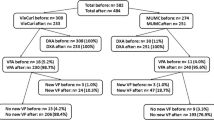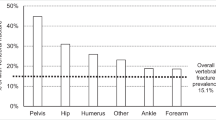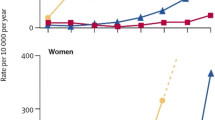Abstract
Summary
Twenty-five percent of patients with a non-hip non-vertebral fragility fracture have an undiagnosed vertebral fracture detected by vertebral fracture assessment during bone densitometric assessment. The prevalence of an undiagnosed vertebral fracture is higher in older people, and they are more likely to have multiple vertebral fractures.
Purpose
Most vertebral fragility fractures (VFF) have no history of trauma. Vertebral fracture assessment (VFA) during dual energy x-ray absorptiometry (DXA) can be used to detect these VFFs. This study aims to identify the prevalence of undiagnosed VFF in patients presenting with a non-hip non-vertebral fragility fracture.
Methods
Patients identified by the fracture liaison service (FLS) of a large UK university hospital presenting with a non-hip non-vertebral fragility fracture were evaluated from 1 January 2012 to 30 September 2015. Local protocol identified those that would proceed for VFA. Data was collected on patient characteristics, fracture details, bone mineral density (BMD) measurements and VFA results.
Results
Five hundred sixty-seven patients (mean (SD) age, 72 (9.4) years) of mostly women (88.3%) had a VFA performed as part of their DXA assessment. One hundred forty-three patients (25.2%) were identified to have a vertebral fracture, of whom 57.3% of them had one fracture. 49.5% of those with vertebral fractures had BMD measurements diagnostic of osteoporosis. Mean (SD) age was higher in those with vertebral fractures compared to those without; 74.9 (8.3) years vs 70.4 (9.5) years, p < 0.00. Those aged 75 years and over were more likely to have multiple fractures than those younger than 75 years (16.3 vs 4%, p = 0.01).
Conclusion
A quarter of patients presenting with a non-hip non-vertebral fragility fracture have an undiagnosed vertebral fracture. Older people are more likely to have vertebral fractures and more likely to have multiple fractures. VFA during bone densitometric assessment can further aid stratifying future fracture risk.
Similar content being viewed by others
References
Cooper C, Atkinson EJ, O’Fallon M, Melton LJ III (1992) Incidence of clinically diagnosed vertebral fractures: a population based study in Rochester, Minnesota. J Bone Miner Res 7(2):221–227
Cummings SR, Melton LJ (2002) Epidemiology and outcomes of osteoporotic fractures. Lancet 18;359(9319):1761–1767
Rao RD, Singrakhia MD (2003) Painful osteoporotic vertebral fracture. Pathogenesis, evaluation and roles of vertebroplasty and kyphoplasty in its management. J Bone Joint Surg Am 85-A(10):2010–2022
Ismail AA, O'Neill TW, Cooper C et al (1998) Mortality associated with vertebral deformity in men and women: results from the European Prospective Osteoporosis Study (EPOS). Osteoporos Int 8(3):291–297
Kado DM, Browner WS, Palermo L et al (1999) Vertebral fractures and mortality in older women: a prospective study. Study of Osteoporotic Fractures Research Group. Arch Intern Med 14;159(11):1215–1220
Ensrud KE, Thompson DE, Cauley JA et al (2000) Prevalent vertebral deformities predict mortality and hospitalization in older women with low bone mass. J Am Geriatr Soc 48(3):241–249
Nevitt MC, Thompson DE, Black DM et al (2000) Effect of alendronate on limited-activity days and bed-disability days caused by back pain in postmenopausal women with existing vertebral fractures. Fracture Intervention Trial Research Group. Arch Intern Med 10;160(1):77–85
Melton LJ III, Atkinson EJ, Cooper C et al (1999) Vertebral fractures predict subsequent fractures. Osteoporos Int 10(3):214–221
Clark EM, Carter L, Gould VC et al (2014) Vertebral fracture assessment (VFA) by lateral DXA scanning may be cost-effective when used as part of fracture liaison services or primary care screening. Osteoporos Int 25(3):953–964
Genant HK, Wu CY, van Kuijk C, Nevitt MC (1993) Vertebral fracture assessment using a semiquantitative technique. J Bone Miner Res 8(9):1137–1148
Pearson D, Horton B, Green DJ et al (2006) Vertebral morphometry by DXA: a comparison of supine lateral and decubitus lateral densitometers. J Clin Densitom 9(3):295–301
Gallacher SJ, Gallacher AP, McQuillian C et al (2007) The prevalence of vertebral fracture amongst patients presenting with non-vertebral fracture. Osteoporos Int 18:185–192
National Institute for Health and Clinical Excellence (2011) Alendronate, etidronate, risedronate, raloxifene, strontium ranelate and teriparatide for the secondary prevention of osteoporotic fragility fractures in postmenopausal women. NICE guideline (TA161), London
Cosman F, de Beur SJ, LeBoff MS et al (2014) Osteoporosis Foundation (NOF) Clinician’s guide to prevention and treatment osteporosis. Osteoporos Int 25(10):2359–2381
Schousboe JT, Vokes T, Broy SB et al (2008) Vertebral fracture assessment: the 2007 ISCD official positions. J Clin Densitom 11(1):92–108
Acknowledgement
We would like to thank Lindsey Marshall for assisting with interpreting data from the fracture liaison service database.
AC was awarded a travel grant by the “Fundación Española de Medicina Interna” (FEMI) to visit the Nottingham University Hospital NHS trust.
TO is a current recipient of a research training fellowship by the Dunhill Medical Trust (RTF49/0114).
Author information
Authors and Affiliations
Corresponding author
Ethics declarations
Conflict of interest
None.
Rights and permissions
About this article
Cite this article
Reniu, A.C., Ong, T., Ajmal, S. et al. Vertebral fracture assessment in patients presenting with a non-hip non-vertebral fragility fracture: experience of a UK Fracture Liaison Service. Arch Osteoporos 12, 23 (2017). https://doi.org/10.1007/s11657-017-0318-3
Received:
Accepted:
Published:
DOI: https://doi.org/10.1007/s11657-017-0318-3




